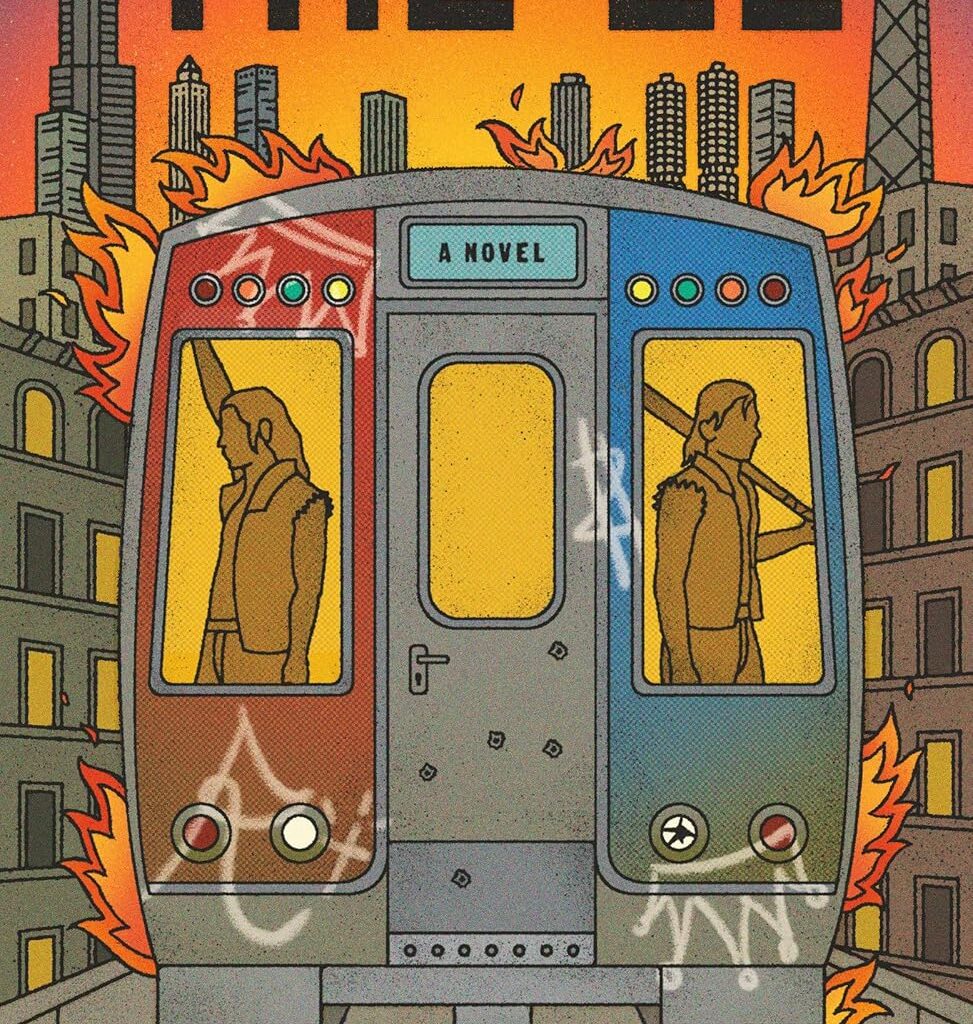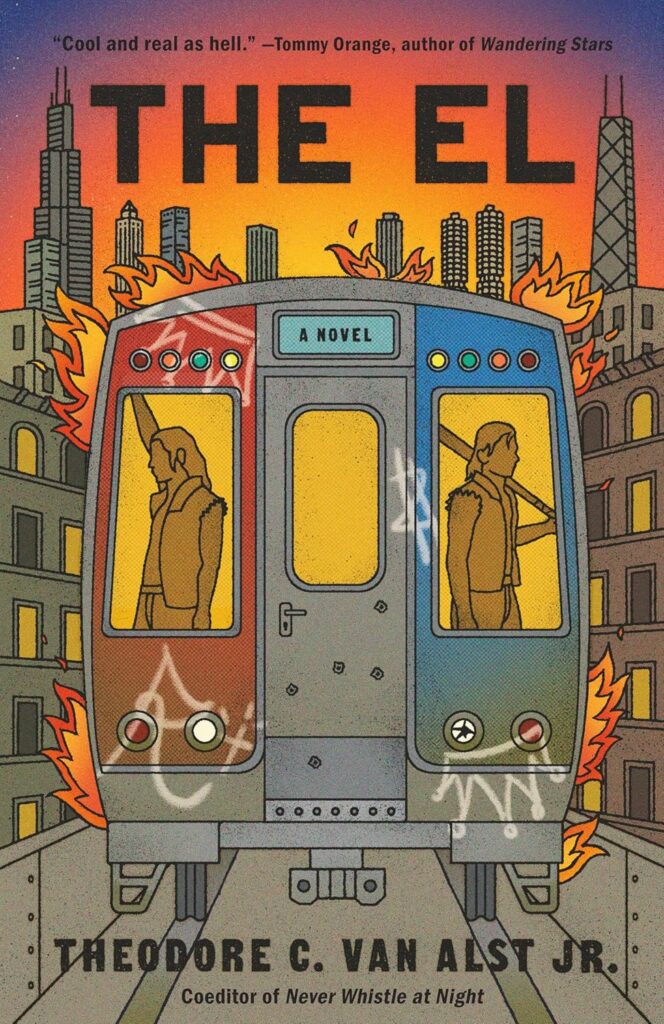The plot of Theodore C. Van Alst Jr.’s debut novel “The El” is simple—it’s one August, 1979 day in the life of a Chicago street gang. The main character, Teddy, must lead a posse of Simon City Royals across the city for a gathering of gangs at Roosevelt High School. A betrayal happens, and some bloody trouble.
But describing the plot does nothing to sum up “The El”—a lively, poetic novel about finding beauty in unexpected places, about seeing things that others don’t see, and seeking love outside of the family of your birth. And it has passages that take your breath away:
Magic light, golden hour, is an amazing time anywhere, but in Chicago it’s otherworldly. Maybe it happens only if you’re from here, in a for real way, but every alley, back porch, park, boulevard, lake, lagoon or river, skyscraper, zoo, school, bridge, or train track shows off its ghosts, their spirits shimmering beside, behind, and above them, frail and pale blue gray, silver highlights cut fleeting outlines at the edge of your vision, all of it coming together to impart an unnamable feeling of calm and wonder that’ll make you get up the next morning just to wait all day for it to come again.
A professor of Indigenous nations studies at Portland State University, Van Alst says that the story about the gang gathering really happened, though the novel is fiction. Inspired by Sol Yurick’s “The Warriors,” “The El” is told mostly by Ted, but it also has the voices of other characters, like Lil Demon and Lil Capone. Gang signs Chicagoans have seen spraypainted on garage roofs and El girders are included in the typescript—a crown for the Imperial Gangsters, for example, and a six-pointed star for the Black Gangster Disciples.
Van Alst started the story because he missed the El and wanted to write a short piece about what it was like riding the train. But then the story opened up, and old friends from his North Side adolescence in the seventies climbed aboard.
“These people hopped on, and it was like, ‘Remember that one time we were all on the El?’ and it took over from there,” says Van Alst.
An enrolled member of the Mackinac Bands of Chippewa and Ottawa Indians, Van Alst is the co-editor of “Never Whistle at Night: An Indigenous Dark Fiction Anthology” and the story collections “Sacred Smokes.” In the book, Ted is the gang’s only Indigenous member, and he calls on the spirit of Coyote to help him in his mission.
Theodore C. Van Alst Jr.
Van Alst says the novel takes place before gang life got scarier in the 1980s. The eighties saw more guns and anonymous violence. For the kids he grew up with, their parents were often not around and gangs were their “made” family.
“You depend on them and you depend on each other… [Something] that was enforced was a sort of loyalty to each other,” Van Alst says. “There were a lot of rules and you just couldn’t break those rules. There was a price to pay for that.”
He says many Native kids in the city are not connected to their heritage, but are trying to figure it out. “Their parents may or may not tell them things and teach them things,” Van Alst says. “There are kids who have grandparents who tell them stories and tell them who they are.”
The character Teddy doesn’t have a mentor—he has been kicked out of his mother’s house and lives with his dad, who’s only peripherally involved, Van Alst says. “I think Coyote steps in and says, ‘I’ll show you some things. It’s not going to be easy. We’re not going to make things easy for you… But it can be done. It’s not a woe-is-us kind of story. I don’t write those kinds of stories. I don’t believe in that. I don’t like that. It will be difficult, but it will be worth it.’”
Part of Ted’s power is his love of the city and of books—he knows Roosevelt was the high school of both Nelson Algren and Shel Silverstein. As he heads off to the gang gathering, Ted carries Mike Royko’s “Boss” in his pocket.
For Ted, “the city is his reservation, it’s where he’s from, he knows the streets, he knows the alleys, he knows how to get around. That becomes an integral part of his life,” Van Alst explains.
In the book’s acknowledgements, Van Alst thanks his wife and children for tolerating his endless talk about his hometown. He calls his city of Portland “cute,” but not Chicago.
“I just love Chicago. I love the roots. I love what it can do, what it stands for, how different it looks from other big cities,” says Van Alst. “Chicago is a really unique place. It’s more a place you’re from than a place you go to. It’s not like New York City, it’s not like Los Angeles. It’s a city of real villages and real folk, and the food is the best in the world. Hands down.”
As a kid, Van Alst says he read everything, including shampoo bottles. He read Edgar Allan Poe and Stephen Vincent Benet in elementary school. “Then when I got older but way too young, I read Stephen King, ‘The Exorcist’ and ‘Jaws,’ things in the popular realm,” he says. Jackie Collins helped him write good dialogue. He also loves Royko. “I was always a Sun-Times guy. You can read it on the El.” Other inspirations include Patricia Highsmith and Catherine Dunne.
“The El” is just 192 pages, a good size for a week of “El” rides to work. Van Alst says he doesn’t like big “chonky” novels. “Try to keep it trim, try to make sure the words count, make the words meaningful and convey things,” Van Alst advises. “I am not averse to writing a sentence somebody might have to read twice, but that’s because I want to convey a lot in that sentence.”
Van Alst says it’s a “crime” that kids these days are less likely to read books. But he notes that kids do read, more than we think. They read short things—memes and stories—and educators must meet them where they are.
He likes short-form writing himself. “With ‘Sacred Smokes,’ every one of them was about long enough to have a cigarette,” Van Alst says.
“I think there are ways to do it, to help people read,” Van Alst says. “I think it’s something smarter people than me need to figure out. But I hope that we do. Because reading is magic. It really is. You’re carrying around an entire world in your head or in your pocket, in a book. There’s nothing else like that. You make an entire world come alive, using words.”
“The El”
By Theodore C. Van Alst, Jr.
Vintage, 192 pages
Mary Wisniewski is a Chicago writer and author of “Algren: A Life.”


